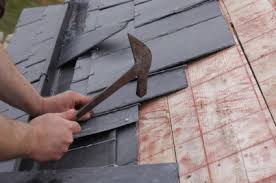Slate is a layered igneous or sedimentary rock, formed by pressure or heat. This makes it easy to split into thin sheets. Slate is water -, acid -, light -, heat (up to 200 degrees Celsius), frost and sea air resistant. It has been used for roofing churches and castles.
 For slate you need a solid surface. Typically, panels or boards were used to nail slate with copper, galvanized or stainless steel nails.
For slate you need a solid surface. Typically, panels or boards were used to nail slate with copper, galvanized or stainless steel nails.
Slats spring back too much to nail (unless you provide a lot of support). On those usually (preformed galvanized) wire hooks are used to hang the slates.
There are many, even artful patterns possible to lay out. Slates scales (Rhine coverage) you can make by chopping off the straight corners of slates. The most commonly used is a stretcher bond with double coverage (Maas coverage, named after the river on which they were supplied). There are thus two slate thickness anywhere above the other, at the overlap even three. This cover method does not have to take into account the prevailing wind direction.
A single horizontal coverage is obviously cheaper, you have less work and less slates needed. You have to take into account the prevailing wind direction.
Slates must have at least 4.5 cm overlap.
Slates tiles
All slates rest on the underlying row. Except for the bottom row. This is why for the first row first is laid a slate thick side strip. Also, we will start with a half slate for the first row. (It's also good to start always with a clean slate.) Fix at once the second row too, so you see where the nails have to come to be covered by the next row.
The slater hammer has a flat handle and the front and rear is chamfered to smooth it and chop slates to size (not chipping). The point is to cut holes in to be nailed slates. The hole is beaten from the underside to the top of the slate so that the head of the nail lies in the wider sprung-out recessed topside. The hole will be beaten with one tap. After practicing this goes without a hitch. The hole should be beaten at least 3 cm from the edge and 2.5 cm from the top.
The slates are not put against each other, but with a groove of 3 mm. The joint is in the middle of the higher-level slate. This gives a stretcher bond.
Nail the slate not too high, they can then be lifted by the wind.
Do not hit the nails too deep. That damages the slate by hammer hits and stress of the pressure of the nail, and the ligature on the underlying slate.
For the cam, the slates have to be laid overlapping 50% in the length.
Slates are natural products, and do not have all exactly the same thickness. Use the thickness to work out inequalities in the shelter.
As you can cut concrete pavers with scissors, you can also cut slate with a slate cutter. You can also easily chop slate. Practice on pieces. They can also be cut by sliding them over a table edge (or slater ‘s stake) and chop with a trowel.
With a pair of pliers you can nibble bits of the slate.
The ripper is a metal jointer shaped blade of 30-50 at 4-5 centimeters with at the head side rear facing notches to pull nails that hold the slates on a roof. You can stab the blade under the (broken) slate, catch the nail in a notch and pull towards you.
